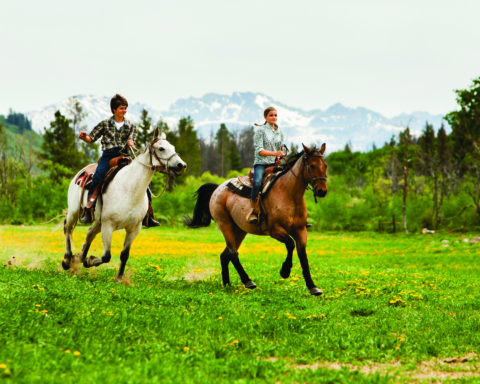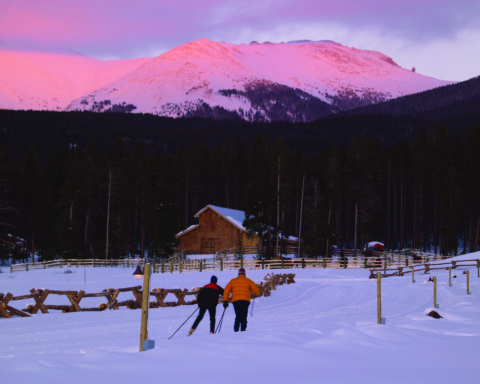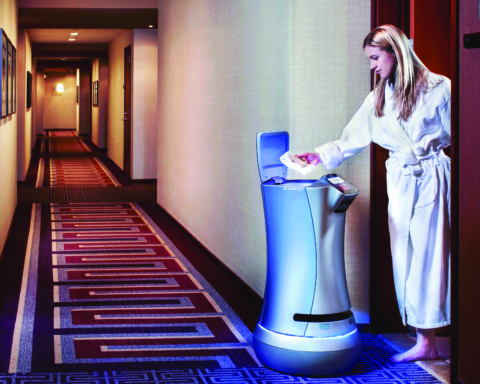By Justin Patrick
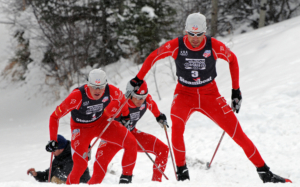
Steamboat Springs produces more winter Olympians than many countries. Over a century, this small town perfected the recipe for producing international champions.
If it takes a village to raise a child, what sort of town does it take to raise an Olympian? Steamboat Springs, best known for its first-class skiing terrain and top-notch accommodations, generates more winter Olympians than any other town or city in North America. Not too shabby for a town of 11,000 permanent residents.
With its own cottage industry cultivating world-class athletes, Steamboat Springs will send more competitors to the 2014 games in Sochi, Russia, than over 50 other nations, according to some estimates. How can a single town, and a remarkably small one at that, find itself on par with
industrialized nations when it comes to producing winter Olympians?
To understand how this cozy mountain community cultivated an athletic powerhouse from within, one must look back
almost a hundred years.
Carl Howelsen, a 1910s Denver resident, could never have envisioned what the ski area he lightheartedly founded nearly a century ago would look like today. Born in Oslo, Norway, in 1877, Howelsen was a gifted skier who helped popularize the sport in its early days. After immigrating to the U.S., he toured with Barnum & Bailey Circus, appearing in acts like “Ski Sailing” and “Sky Rocket,” wowing audiences with his mastery of a sport still considered strange and mysterious by most Americans. He eventually made his way to the Rocky Mountains to an isolated town named after the sound of bubbling hot springs closely resembling the noise of a passing steamboat.
Though residents at the time, mostly ranchers and miners, had adopted skiing as an effective mode of transportation during winter, they were greatly amused by Howelsen’s construction of a ski jump in 1914. The “Flying Norseman” introduced his neighbors to the sport by landing a 100-foot jump in what is now downtown Steamboat. Howelsen’s Hill, the oldest continually operating ski area in Colorado, now contains regulation 30-, 50-, 70-, and 90-meter jumps used for training by Olympians. He is regarded as a pioneer of skiing in America, and his legacy earned him an induction into the Colorado Ski and Snowboard Hall of Fame in 1977.
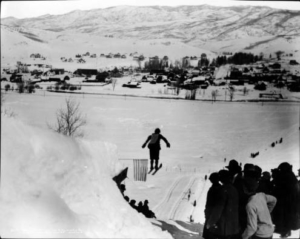 Today, much of the Olympic training occurs at the Howelsen Hill Nordic Center in down-town Steamboat. It contains a meticulously groomed alpine ski area, an ice-skating rink, Nordic jumping hills, a terrain park and a network of Nordic cross-country skiing trails.
Today, much of the Olympic training occurs at the Howelsen Hill Nordic Center in down-town Steamboat. It contains a meticulously groomed alpine ski area, an ice-skating rink, Nordic jumping hills, a terrain park and a network of Nordic cross-country skiing trails.
Because Steamboat Springs developed relatively early as a ski resort, it was able to nurture a love and respect for the sport for over a century. It also consequently developed some unique assets that set it apart. As more of its children pursued skiing as a disciplined passion, and as the mountain’s reputation grew and attracted young athletes from abroad, Steamboat became increasingly serious about competition. It needed organized institutions to provide a framework for growth.
The Steamboat Springs Winter Sports Club (SSWSC), founded in 1914, has burgeoned into an internationally lauded institution that provides winter and summer athletic programming for over 1,000 children and adolescents of various ages, abilities and pursuits. But it is all extracurricular. To compensate, many of its members are also students at the Lowell Whiteman School. The private school was founded in 1957 by an outdoorsman with a passion for teaching who hoped to combine education with sport. The school continues to stay true to its original mission; one might say they’ve finessed it to a science.
Most everyone associated with these two organizations agrees that they are codependent. Many Whiteman students are avid winter athletes, and the school offers programs to balance academics with intense training. The Whiteman School and SSWSC work in close conjunction to foster a community-supported youth development program that has instilled a lifelong love of snow sports in countless graduates. And, yes, a healthy number of its members have gone on to land spots on the U.S. Ski Team and compete in the Olympics.
Johnny Spillane is one of the more notable examples of how an environment that nourishes potential can turn a kid who just loves to rip down a ski slope into an international legend. Spillane is a Steamboat Springs native and went through both the Whiteman School and the SSWSC. He won three silver medals in Nordic Combined Skiing in Vancouver in 2010 and is currently preparing for his fifth Olympic appearance. “I am very fortunate to have grown up in Steamboat,” says Spillane, 34, who is raising his two daughters there. “There is tremendous opportunity to become a great skier because of the atmosphere that Steamboat has created. You get to grow up skiing with Olympians; it gives you a different kind of motivation and dedication to become the best that you can.”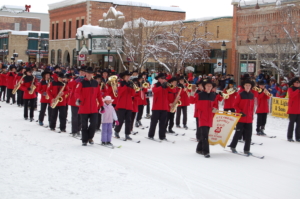
Joe Roberts, a retired Whiteman School teacher, agrees that there are powerful forces at work. “The town permeates skiing in the United States in so many ways,” he says. In his opinion, no single entity can claim credit for its success. It’s attributable to the manner in which several moving parts come together. “I’m looking at this as a package. You look at the history, you look at the Winter Sports Club, you look at the development of the ski area, and you look at Whiteman School. It’s a package.”
Indeed, the combined elements found in Steamboat Springs have produced more than 75 Olympians throughout history. Whiteman alone has sent students and alums to every recent Winter Olympics. In ’94, five students competed in Lillehammer. In ’98, six students went to Nagano. Five went to Salt Lake in ’02, seven to Torino in ’06, and seven to Vancouver in ’10. Insiders are hoping the record will be broken in Sochi. Notable Olympians Ryan St. Onge, Michelle Gorgone, Travis Mayer and Johhny Spillane, amongst others, are graduates of the Whiteman School.
“It’s a mecca,” says Roberts, speaking of Steamboat Springs. Children who are born there —
often to parents who view walking and skiing as equally important hallmarks of child development — are brought up in a culture that encourages healthy, but also very serious, competition. Additionally, promising young athletes move to Steamboat with their families from around the globe to test and develop their skills alongside similarly talented children under the guidance of world-class coaches. “The kids know if they have the ambition, if they have the talent, then they can work their way up,” says Roberts. “In the locker rooms, athletes who are very high powered will be in the kids’ presence…. It’s very compelling. It gives them something to shoot for.”
Those locker rooms are found inside the grounds of the Steamboat Springs Winter Sports Club. SSWSC is a 501c(3) non-profit. It is a private club, not owned or managed by either the city or ski area, though they do happen to be its two biggest supporters. Given its size and scope, meeting fundraising needs is a constant challenge.
Perpetuating the organization’s existence through fundraising depends on not only consistently producing Olympic-level results, but also offering something for everyone who walks in the door. Actually, that the organization reliably churns out elite athletes is more of a byproduct of its dedication to its mission, which is to offer a satisfying experience to all of its members.
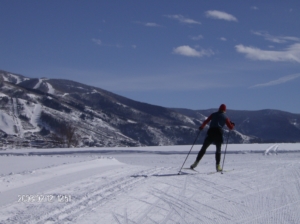 Rick DeVos has been the executive director of the SSWSC since 1999, a position he accepted after working for the Steamboat Springs ski area overseeing the ski school and its racing program. DeVos estimates over 18,000 young athletes have been involved in the club, which is the oldest of its kind west of the Mississippi. To date, the SSWSC has over 1,000 members under the guidance of about 150 staff, most of whom are coaches.
Rick DeVos has been the executive director of the SSWSC since 1999, a position he accepted after working for the Steamboat Springs ski area overseeing the ski school and its racing program. DeVos estimates over 18,000 young athletes have been involved in the club, which is the oldest of its kind west of the Mississippi. To date, the SSWSC has over 1,000 members under the guidance of about 150 staff, most of whom are coaches.
“We offer programming in more sports than any winter club in North America,” he says. Fifty-one programs train children from the age of 3 and up, the most active of them in their early to mid teens. There is also an adult masters racing program; its oldest competitor is 80. The youngest athletes start in the alpine ski division learning the basics, including adapting to cold-weather conditions and high altitude. The goal is “to teach them the love of the sport.” As they get older, participants who stick with the program tend to specialize and receive training tailored to their passions.
SSWSC utilizes age-specific products designed to maximize potential in a developing athlete. But as DeVos stresses, SSWSC’s mission is not to produce Olympians, but to provide an atmosphere that accommodates its members’ many interests and skill levels. “It’s all kind of blended,” he explains. “For every kid that’s in this, number one we’re going to try to help them be able to afford it, and number two to meet their goals, not necessarily ours. But that means we have to have a product mix from completely recreational to Olympian-based.”
As far as high-stakes comp-etition goes, the philosophy is that greatness must be encouraged and fostered, not demanded. It is up to the individual athletes and their families to go all in. “The kids that have the passion required to be an upper-level athlete…it’ll show itself,” says DeVos.
The elite athletes headed for higher competition do so because they want to, but their success is dependent on the support of other individuals and the community at large. Steamboat culture embraces the notion that striving towards greatness is a team effort, and if everyone does their best, the fruits of that labor will show eventually. “There are a lot of factors that can make an Olympian,” muses Johnny Spillane. “Hard work, dedication, commitment, courage and a little luck all factor in, but your support team is also very important. You need a lot of
help to be successful.”
Despite earning a name for their remote town on the world stage, Steamboat’s residents ultimately believe it’s about having fun and enjoying mountain sports, a practice that lends itself to a way of life they relish.
SSWSC members and Whiteman School students will tell you that winter sports are about more than winning awards. They inherently generate a respect for nature, an appreciation of recreation wholly dependent on mountains and snowfall. And surrounded by vast expanses of wilderness where human civilization is the exception, they force an understanding of the real value of mutual sacrifice and teamwork.
Triumph in a place like Steamboat exists because of a community-wide effort to give and help and support. It is a powerful force that cannot easily be mimicked, and the reason that Olympians from Steamboat Springs attribute much of their success to the town year after year.



